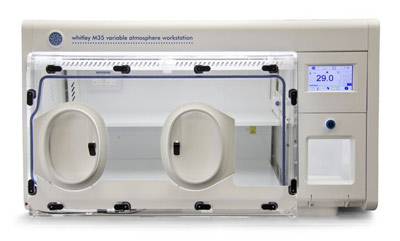
One third of the world population, among them 10-15 million Americans, are estimated to have latent tuberculosis, and the risks of reactivation and subsequent spread of the disease hinge on the effective treatment and suppression of the persisting mycobacteria. The growth rate of Mycobacterium tuberculosis is a function of dissolved oxygen tension, and as hypoxic granuloma form during the process of immunologic containment, growth of the bacilli slows until a metabolically active but non-replicating state is achieved. Don Whitley Scientific workstation users Watanabe et al. of the NIH in Maryland analyzed the metabolic adaptation of M. tuberculosis to extreme hypoxia, specifically asking how basic physiologic functions can be upheld in latent TB infection (“Fumarate Reductase Activity maintains an Energized Membrane in Anaerobic Mycobacterium tuberculosis”; PLoS Pathogens 7.10, 2011).
In the latent form, microaerophilic conditions (1-2 mmHg dissolved O2) and the presence of reactive nitrogen intermediates in the granuloma cause a switch in respiratory pathways and electron flow/proton pumping pathways. Fermentors and the Don Whitley Scientific anaerobic workstation MG1000 were used in the Watanabe lab to create hypoxic and anaerobic conditions, respectively, to examine metabolism under precisely defined oxygen conditions. Decreases in ATP synthesis and increased levels of reduced cofactors such as NADH resulted under oxygen depletion in vivo and in the in vitro systems created by Watanabe, and enzymes of the reductive branch of the TCA cycle were significantly upregulated. Fumarate reductase A was upregulated 212-fold in hypoxic cultures of M. tuberculosis, and succinate accumulated in the extracellular milieu through the reductive TCA cycle. Thus, M. tuberculosis maintains an energized membrane by fermentation despite a reduced capacity for NADH reoxidation. The M. tuberculosis genome encodes several homologous fumarate reductase/succinate dehydrogenase complexes, providing a considerable degree of metabolic plasticity.
Watanabe et al. propose that targeting the fermentation processes maintaining metabolism in the low oxygen granuloma environment of latent TB infection will provide a more effective therapy than the currently used isoniazide, which inhibits mycolic acid biosynthesis needed for the cell wall and thus only slows growth of the bacilli. Labs such as this one at NIH researching infectious diseases are able to re-create extremely hypoxic or anaerobic microenvironments inside the closed cell culture HypOxystation (Don Whitley Scientific) or M35 Microaerophilic workstation by adjusting oxygen, CO2, temperature, and humidity.


